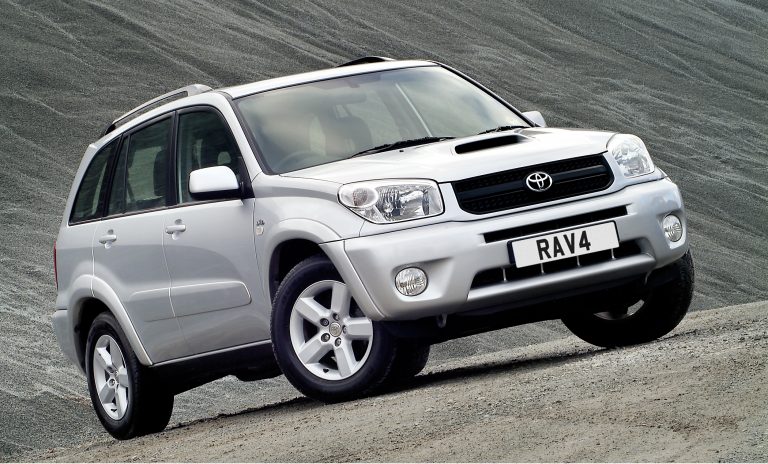RAV4 2006 When the RAV4 first hit the market, it marked a radical departure from what consumers typically considered an SUV. Smaller and lighter than its competition, with its distinctive body design.
Toyota made changes to the RAV4 for 2006 that saw it get larger, including adding a 269 horsepower V-6, as well as being transformed from cute into more of an utilitarian utility ute.
Safety
Families buying SUVs place great importance on car safety, and the RAV4 boasts an excellent track record. Its front airbags earned four-star ratings in IIHS crash tests while Toyota’s Star safety system includes stability control, traction control and four-wheel antilock brakes; additionally an on-demand four-wheel drive system automatically divides power between front and rear axles as conditions dictate.
Redesigned rear seats are comfortable and roomy, featuring fore/aft adjustment in a 60/40 split spot and backrest recline. Cargo bay space may be limited; but its ultra-low liftover height makes loading gear effortless when parallel parking. Unfortunately, however, side-swinging tailgate arcs too closely to curb and makes opening it difficult when there are cars nearby parked directly behind one another.
Older models of Toyota RAV4s have been known to squeal under hard acceleration, likely caused by uneven tire wear or improper inflation. Furthermore, some RAV4s fail to start when their keys are turned; this may be caused by worn contacts in the starter-motor solenoid; replacing these is relatively cheap and easy. Furthermore, this car comes backed with 36 months/36,000 mile basic and 60 months/60,000 mile powertrain warranties as well as three-year/36k mile corrosion protection warranties; both basic models come equipped with CD player and tilt steering wheels while navigation systems can be added onto Limited versions for additional benefits.
Fuel Economy
RAV4s come equipped with both a standard 166-hp 2.4-liter twin-cam four and an optional 269-hp V6, both featuring Toyota’s Active Torque Control system to apportion power between front and rear wheels depending on road conditions. Two-wheel-drive versions boast competitive fuel economy ratings: 24/30 for city/highway driving respectively. This vehicle’s primary strength lies in its responsive handling; even when hauling full loads or accelerating up to highway speeds you can leverage its agile handling for optimal control.
Customers looking for more than utility will likely prefer the V6, as its superior acceleration and towing capacity (up to 3,500 pounds) make it ideal. But note that it requires premium fuel, while its on-demand system may be less effective than permanent four-wheel-drive modes.
One annoyance reported by owners is clunking and knocking noises when making left or right turns from their steering wheels, likely caused by worn intermediate shafts which cost $320-$480 depending on your model. Other problems can include leaky water pumps (part of engine cooling systems), intermittent wiper switches that won’t switch off properly and intermittent wiper switches that cannot be disabled.
Design
The RAV4 was the first SUV to use a unibody passenger-car platform, revolutionizing small SUV market. Furthermore, it pioneered using unitized chassis instead of traditional ladder-frame truck chassis to improve rigidity and refinement; thus paving way for further innovations from this fourth-generation model with updated exterior design, increased interior comfort features and additional equipment available for purchase.
Designed to appeal to younger buyers, its exterior appears more modern and sexy while its interior boasts bright switchgear that should appeal to teenagers. The second seat can be adjusted forward/aft for easy seating for two, and third row space is tight but manageable with small children.
This RAV4 is built on Toyota’s new GA-K (Global Architecture) platform, which is 57% more rigid than its predecessor and boasts multi-link rear suspension to provide ideal damping to enhance handling and reduce cabin noise. Furthermore, Vehicle Stability Control and Traction Control systems go beyond traditional stability controls to actively prevent spins and skids for enhanced control during driving conditions.
The hybrid powertrain of the Ford Escape Hybrid is comprised of a 2.5-liter Atkinson cycle four-cylinder engine, high voltage generator, 204 cell nickel metal hydride battery in front of cargo bay, and an electric motor driving the rear wheels as needed – producing 215 combined horsepower while attaining an EPA rating of 24 miles per gallon for AWD form.
Performance
Performance wise, the RAV4 delivers on both acceleration and handling abilities, offering quick acceleration while remaining very quiet during driving. It’s available with many premium features – like its six speaker audio system that features MP3 compatibility – plus its powerful engine which can reach 60mph in under one minute and features such as traction control and stability control systems to keep drivers safe while on the road.
RAV4 2006 Toyota introduced interior changes for the RAV4 in 2006. The cabin now sports a more contemporary design with less decorative gimmicks. Its 166 horsepower four-cylinder inline-four engine now drives power directly to either front wheels or all four through an automated four-speed transmission – earning it an EPA city/highway fuel economy rating of 24/30 with 2WD models and 23/28 when equipped with 4WD systems.
Standard features of this model include air conditioning, cruise control and an AM/FM/CD/MP3/WMA stereo with six-speakers. It comes equipped with both manual driver seat adjustment and an adjustable front passenger seat; plus its spacious cargo area can easily hold a small trailer. Four-wheel antilock disc brakes as well as Toyota’s VSC stability and traction control are standard as well.
The RAV4 has an attractive exterior, featuring a sleek clamshell-style hatchback with low beltline. Inside is equally well-appointed with large underfloor storage area and plenty of cubbies for holding drinks or small items such as keys. Unfortunately, its side-swinging rear door can be awkward at times and doesn’t offer enough protection from the elements.

